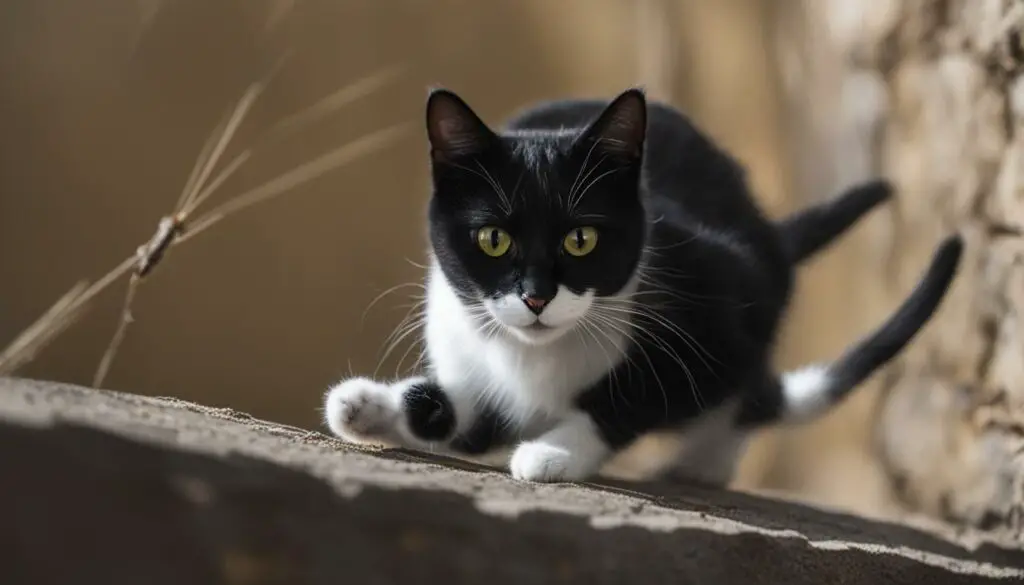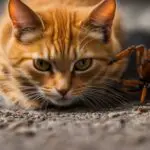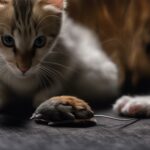Hello, readers! Today, I want to explore the fascinating world of cats and their interactions with spiders. Have you ever wondered if cats have a natural ability to kill spiders? Well, you’re in the right place! In this article, we will delve into the key aspects of the feline-spider interaction and discover why cats are known as natural predators. Get ready to uncover the secrets behind cats’ hunting instincts, spider behavior, and the consequences of their fascinating interaction.
But first, let’s address the burning question: Do cats kill spiders? The answer is a resounding yes! Cats have an innate hunting instinct that drives them to chase and capture small prey, including spiders. This behavior is deeply rooted in their nature, drawing from their wild ancestors and centuries of domestication. Understanding the dynamics of the feline-spider interaction can provide valuable insights into pest control and the ecological role of cats in managing insect populations.
Key Takeaways:
- Cats are natural predators with a strong hunting instinct.
- They play a significant role in pest control by hunting and killing spiders.
- Understanding cat behavior and spider anatomy helps explain their interaction.
- Cats contribute to natural insect population control.
- It is important to strike a balance between cat hunting behavior and wildlife conservation.
The Hunting Instinct of Cats
Cats possess a strong hunting instinct that stems from their predatory nature. From a young age, kittens display behaviors associated with hunting, such as stalking and pouncing. This instinct is deeply ingrained in their genetic makeup and has evolved over time. Cats have developed various techniques to capture and kill their prey, demonstrating their prowess as skilled hunters.
When it comes to hunting, cats rely on their exceptional agility, keen senses, and stealth. They prefer to hunt alone, leveraging their natural camouflage and patience to remain undetected by their prey. Cats use their acute hearing and sight to pinpoint the location of their targets, employing stalking techniques to inch closer. Their hunting instincts guide them as they carefully observe their surroundings, waiting for the perfect moment to strike.
While cats are versatile hunters, their prey preferences may vary. Some cats display a keen interest in capturing small rodents, while others focus more on birds or insects. This diversity in prey preferences can be attributed to individual cat personalities and experiences. Observing a cat in pursuit of its chosen prey is a fascinating display of their hunting skills and finely-tuned instincts.
“Cats are natural-born hunters, with an innate ability to stalk and capture their prey. Their hunting instincts are honed through practice and observation, making them formidable predators.”
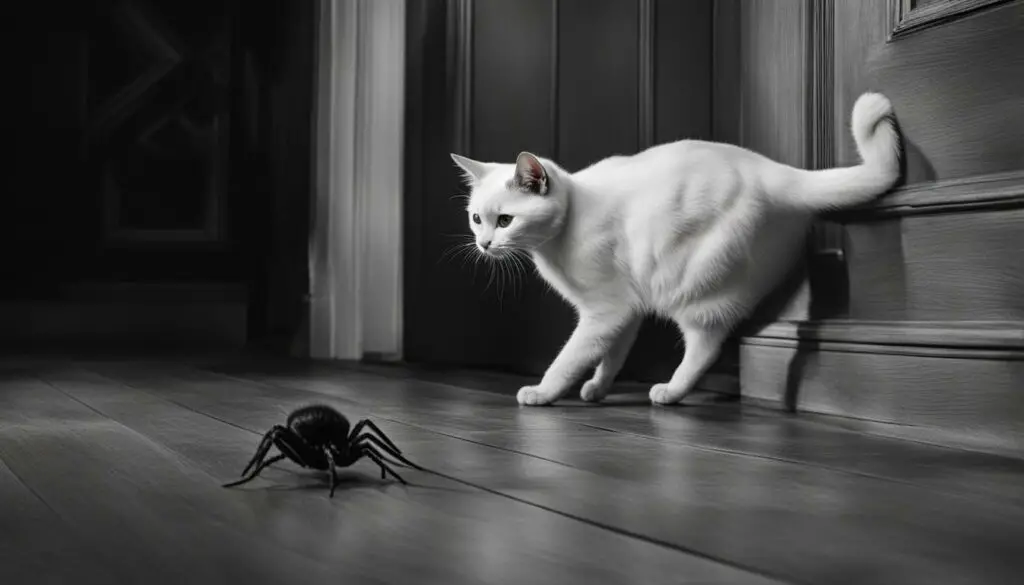
| Hunting Techniques | Description |
|---|---|
| Stalking | Cats rely on stealth and patience to silently approach their prey, minimizing the chances of detection. |
| Pouncing | Once in range, cats use their powerful hind legs to leap forward and capture their prey with precision. |
| Play Hunting | Cats engage in mock hunting behavior as a form of play, sharpening their skills and satisfying their instincts. |
| Trap and Capture | Cats employ strategies to corner their prey, utilizing their quick reflexes to swiftly capture and secure their target. |
The hunting instinct of cats is an innate characteristic that contributes to their overall well-being. It allows them to engage in natural behaviors, providing mental and physical stimulation. Understanding and appreciating the hunting instincts of cats can help us foster a supportive environment that acknowledges and channels their natural predatory abilities.
Section 3: The Anatomy of Spiders
To understand the interaction between cats and spiders, it is essential to know the anatomy of spiders. Spiders are arachnids with eight legs and multiple pairs of eyes. They have fangs that are used for injecting venom into their prey. Spiders use their silk to create intricate webs for prey capture and as a means of locomotion. Understanding the behavior and anatomy of spiders helps in understanding how cats interact with them.
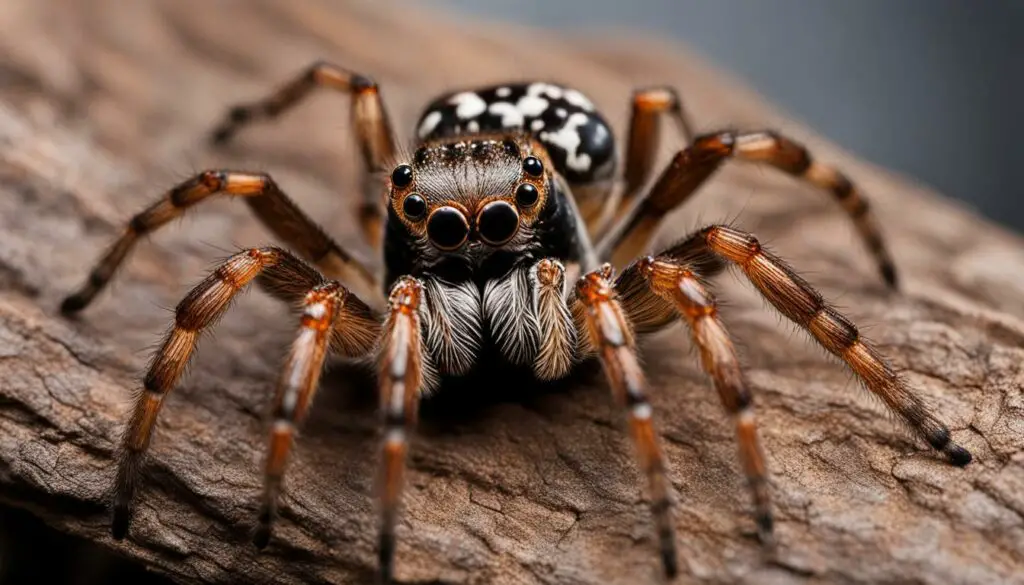
“Spiders are arachnids with eight legs and multiple pairs of eyes. They have fangs for injecting venom into their prey and use their silk to create intricate webs for prey capture and locomotion.”
Knowing the anatomy of spiders provides insights into their behavior and how they interact with their environment. With eight legs, spiders have excellent mobility, allowing them to navigate various surfaces and build intricate webs. Spider webs are not only a means of catching prey, but they also serve as a mode of transportation for spiders, enabling them to move from one location to another. The silk produced by spiders is strong and sticky, making it ideal for capturing and immobilizing their prey.
Additionally, spiders possess fangs that they use to inject venom into their prey. Venomous spiders, such as the black widow or brown recluse, have venom that can cause harm to humans and animals. Understanding the anatomy of spiders and their venomous capabilities is crucial for assessing the potential risks associated with spider-cat interactions.
| Spider Anatomy | Description |
|---|---|
| Legs | Spiders have eight legs, which provide them with excellent mobility and agility. |
| Fangs | Spiders have fangs that they use to inject venom into their prey. |
| Silk | Spiders produce silk, which they use to build intricate webs for prey capture and as a means of transportation. |
| Eyes | Spiders have multiple pairs of eyes, which vary in number depending on the species. |
Cats as Natural Predators
Cats have long been known for their hunting prowess and natural instinct to prey on small creatures, including spiders. With their sharp claws, keen eyesight, and lightning-fast reflexes, cats are efficient arachnid predators. Their skill in capturing and eliminating spiders makes them valuable allies in insect control and pest management.
By hunting and killing spiders, cats help regulate spider populations, preventing potential infestations in homes and gardens. This natural form of insect population control contributes to a healthier and more balanced ecosystem. Cats’ innate ability to locate and capture spiders enables them to play a vital role in minimizing the presence of these arachnids.
Furthermore, cats’ hunting behavior extends beyond spiders to other household pests, such as mosquitoes, flies, and rodents. Their predatory nature and remarkable agility enable them to keep these common pests at bay, reducing the need for chemical insecticides or extermination methods. Their role as bug hunters not only benefits humans by eliminating unwanted pests but also aids in maintaining the delicate balance of nature.
| Cats as Natural Predators | Insect Control | Pest Management | Arachnid Predators | Spider Populations | Insect Population Control |
|---|---|---|---|---|---|
| Contributes to natural pest control | Regulates insect populations | Helps manage pest issues | Efficient at hunting spiders | Keeps spider numbers in check | Reduces overall insect populations |
| Minimizes reliance on chemical pesticides | Reduces the need for insecticides | Offers a natural pest management solution | Preys on various arachnids | Prevents spider infestations | Contributes to a healthier ecosystem |
With their innate hunting abilities, cats serve as natural predators that help control insect populations, including spiders. Their contribution to pest management and insect control is a testament to their exceptional skills as well as their valuable role in our lives. By embracing and appreciating cats as natural predators, we can foster a better understanding of their impact on the environment and encourage responsible ownership to ensure their well-being.
Cat and Spider Interaction
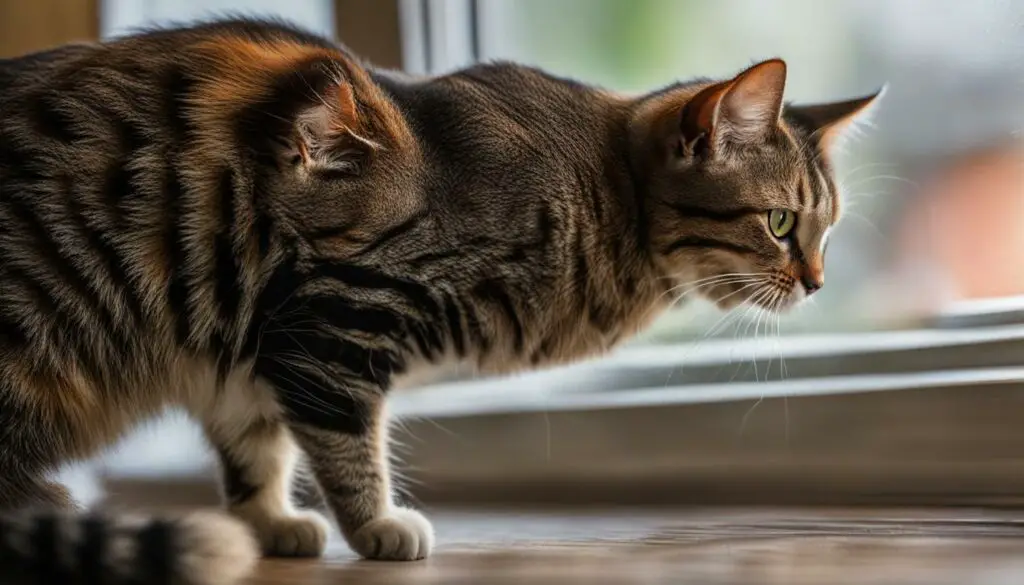
Cats and spiders are no strangers to each other, and their interactions can be fascinating and varied. While some cats may be indifferent or even fearful of spiders, others may actively hunt and engage with them. This cat-spider interaction is shaped by a multitude of factors, including the individual cat’s personality and experiences, as well as the specific spider species involved.
Fear of spiders, known as arachnophobia, is a common sentiment among humans. Interestingly, some cats may also exhibit fear or aversion towards spiders. This fear can be attributed to several reasons, such as previous negative encounters or a natural instinctual response to potentially venomous spiders. Just like humans, cats can develop phobias based on their experiences and associations.
It is important to note that not all spiders are harmless, and some species can be toxic or venomous. Spider bites can pose a risk to both cats and humans, leading to potential health concerns. Therefore, it is crucial to ensure the safety of both cats and humans by minimizing the chances of spider bites through preventive measures and creating a safe environment.
The Role of Spider Phobia
Spider phobia and fear of spiders can impact both cats and humans’ behavior and well-being. For instance, a cat with a fear of spiders may exhibit avoidance behavior or show signs of anxiety when encountering spiders. Similarly, humans with arachnophobia may experience heightened fear or discomfort in the presence of spiders. Understanding and addressing these phobias can help create a more harmonious environment for both cats and humans.
Key Takeaways:
- Cat and spider interactions can vary, with some cats actively hunting and engaging with spiders, while others may exhibit fear or avoidance.
- Fear of spiders, or arachnophobia, can be present in both cats and humans and may impact their behavior and well-being.
- Spider bites can pose a health risk to cats and humans, necessitating precautionary measures to ensure safety.
- Understanding and addressing spider phobia can help create a more harmonious coexistence between cats, humans, and spiders.
The Role of Cats in Pest Control
Cats play a crucial role in pest control, using their innate hunting skills to keep insect populations in check. With their sharp reflexes and keen senses, cats are natural bug hunters, making them valuable assets in managing household pests such as spiders. By actively hunting and killing insects, cats contribute to a natural form of pest control, which can be advantageous for those who prefer a more environmentally friendly approach.
Indoor and outdoor pests alike are no match for the hunting prowess of cats. Whether it’s spiders lurking in the corners of your home or pesky insects in your garden, cats can help eliminate these unwanted intruders. Their ability to detect and track movements combined with their agility allows them to swiftly capture and dispatch their prey, making them effective exterminators.
Unlike traditional pest control methods that rely on chemicals or insecticides, cats offer a sustainable and eco-friendly solution. By harnessing the natural predatory instincts of feline companions, households can reduce their reliance on harsh chemicals while maintaining a pest-free environment. Additionally, cats’ hunting activities can help prevent infestations, ensuring a healthier and more hygienic living space.
| Advantages of Cats in Pest Control | Limitations of Cats in Pest Control |
|---|---|
|
|
While cats offer numerous benefits in pest control, it’s important to acknowledge their limitations. Cats may not be effective against all pests, especially larger or more resilient insects. Additionally, each cat’s hunting behavior can vary, meaning some cats may not actively engage in pest control. It’s essential to understand and respect the individual nature of cats when considering them as bug hunters.
Furthermore, it’s crucial to ensure responsible cat ownership to minimize any potential risks to wildlife. Cats are natural predators, and their hunting activities can have adverse effects on local ecosystems. Taking measures such as spaying and neutering, keeping cats indoors, and providing environmental enrichment can help mitigate these impacts and promote a balanced coexistence between cats, humans, and the environment.
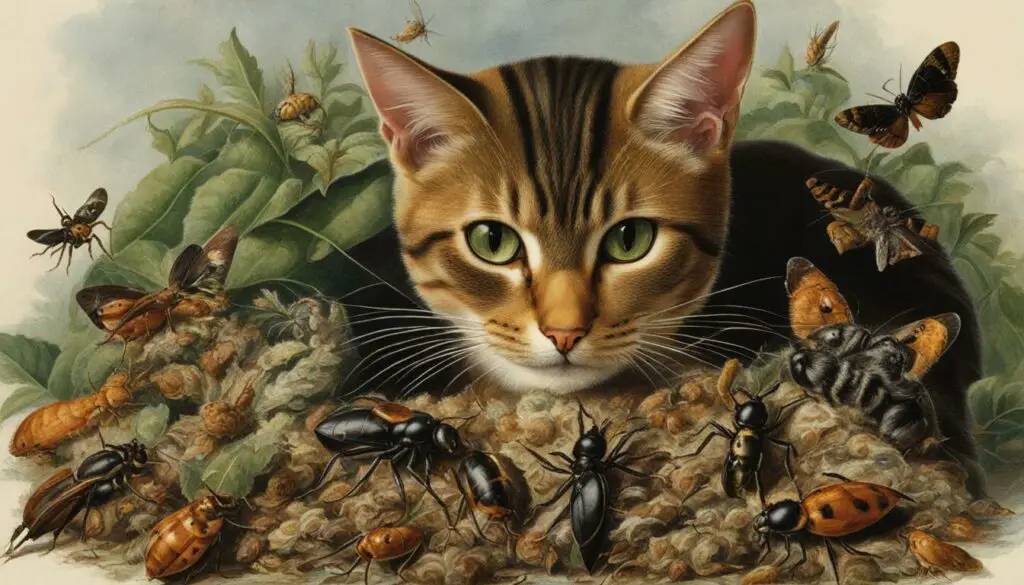
Cat Myths and Facts about Spiders
When it comes to cats and their interaction with spiders, there are many myths and misconceptions. Some people believe that cats are highly effective spider hunters, while others think that cats are afraid of spiders. The truth is that cats exhibit individual variations in their behavior towards spiders. While some cats may actively hunt and kill spiders, others may show fear or avoidance. It’s important to understand the facts about spider behavior and the role of cats in spider population control to dispel these common myths.
Spider myths often stem from misconceptions about the behavior and capabilities of both cats and spiders. While cats have a natural hunting instinct and can be skilled predators, their success in hunting spiders can vary. Some cats may show little interest in spiders or may prefer other types of prey. On the other hand, some cats may have a particular fascination with spiders and actively seek them out.
Spider facts are important to consider when evaluating the role of cats in spider population control. Spiders are highly adaptable creatures with diverse behavior patterns. Their ability to reproduce quickly and spin intricate webs allows them to thrive in many environments. Cats can contribute to spider population control by hunting and killing spiders, but their impact may vary depending on the individual cat, the spider species, and the local ecosystem. It’s essential to understand that cats are just one piece of the puzzle when it comes to managing spider populations.
“Cats can contribute to spider population control, but their impact may vary depending on the individual cat, the spider species, and the local ecosystem.”
To better understand the complexities of cat-spider interaction and spider population control, it’s important to consider both the innate behavior of cats and the characteristics of spiders. By dispelling myths and understanding the facts, we can appreciate the unique dynamics between cats and spiders and make informed decisions about pest management in our homes and environments.
| Myth | Fact |
|---|---|
| Cats are afraid of spiders. | Cats exhibit individual variations in their behavior towards spiders, ranging from fear to active hunting. |
| Cats are highly effective spider hunters. | While cats have a natural hunting instinct, their success in hunting spiders can vary. |
| Cats can completely eliminate spider populations. | Cats can contribute to spider population control, but their impact may vary depending on various factors. |
The Ecological Impact of Cats Killing Spiders
When considering the interaction between cats and spiders, it is important to assess the ecological impact of cats killing spiders. While cats contribute to arachnid control and insect population control, their hunting behavior can have unintended consequences for the environment. The relationship between cats and spiders can disrupt the natural balance of ecosystems and impact wildlife conservation efforts.
Spider ecology is intricately connected to the overall health of ecosystems. Spiders play a vital role in controlling insect populations and maintaining the delicate balance of the food chain. By hunting and killing spiders, cats can influence the population dynamics of these arachnids. This can potentially lead to a decrease in spider populations, disrupting the natural control of insects and affecting the broader ecosystem.
Wildlife conservationists are particularly concerned about the impact of cats as invasive predators. While cats are proficient hunters, their presence in sensitive habitats can have detrimental effects on local wildlife populations. Responsible cat ownership, including measures to control their population, is crucial for minimizing the ecological impact of cats hunting spiders and other prey.
| The Ecological Impact of Cats Killing Spiders | |
|---|---|
| Impact | Description |
| Decreased spider populations | Cats hunting and killing spiders can lead to a decrease in spider populations, potentially disrupting the natural control of insects. |
| Disruption of the food chain | By influencing spider populations, cats can disrupt the delicate balance of the food chain and impact the ecological dynamics of ecosystems. |
| Threat to wildlife | Cats as invasive predators can pose a threat to local wildlife populations, especially in sensitive habitats. |
While cats have their role in pest control, it is essential to consider the broader ecological implications of their hunting behavior. Striking a balance between cat ownership, responsible pet management, and wildlife conservation efforts is crucial for maintaining the health and sustainability of ecosystems.
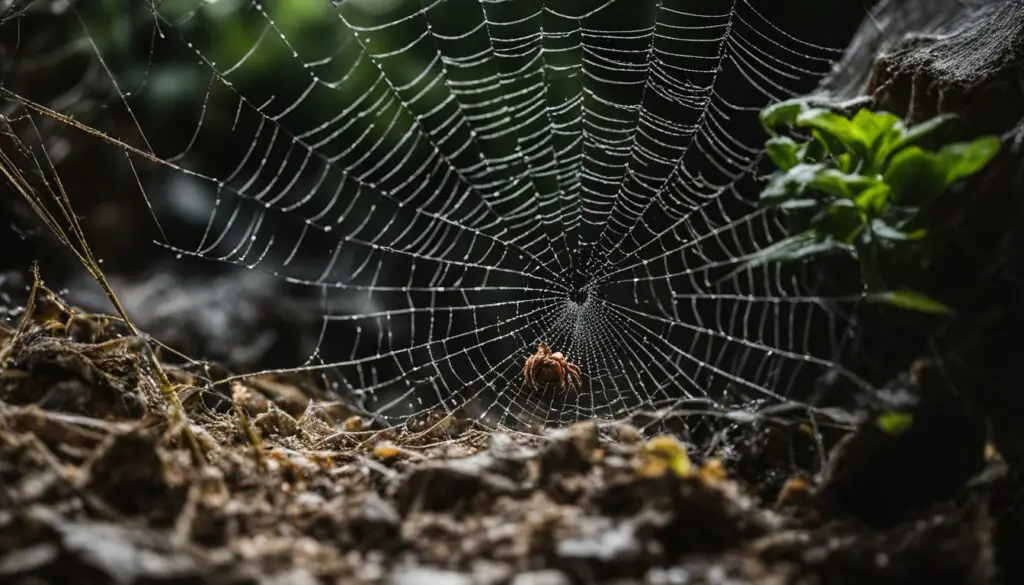
Preventing Cat-Spider Interactions
When it comes to preventing cat-spider interactions, there are several measures that can be taken to ensure the safety of both cats and spiders. One effective strategy is to keep cats indoors, as this reduces their exposure to spiders and other potential hazards. Indoor cats are less likely to come into contact with spiders, minimizing the risk of bites or other negative interactions. Additionally, providing environmental enrichment and interactive play for cats can help redirect their hunting instincts and keep them mentally stimulated, reducing their desire to hunt spiders.
In some cases, cats may exhibit fear or phobia towards spiders. This can lead to avoidance behaviors or distress for both the cat and the spider. If your cat shows signs of spider phobia or fear, it is important to address these concerns. Gradual desensitization techniques, such as introducing spiders in controlled environments, can help alleviate fear and create a more harmonious spider-human-cat interaction. Seeking professional help from a veterinarian or animal behaviorist may also be beneficial in managing spider-related fears in cats.
Keeping cats indoors not only prevents cat-spider interactions but also has other benefits. It helps protect cats from outdoor dangers such as traffic accidents, diseases, and attacks from other animals. Indoor cats generally live longer and have reduced risks of injuries and health issues. By creating a safe and cat-friendly environment, we can ensure the well-being of our feline companions while minimizing the chances of spider-related incidents.
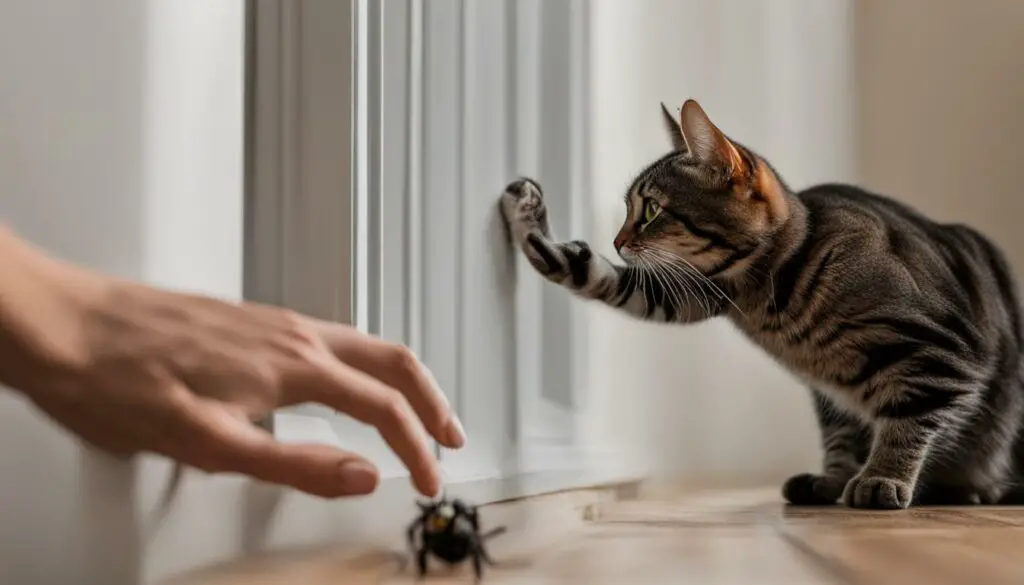
Table: Tips for Preventing Cat-Spider Interactions
| Tips | Description |
|---|---|
| Keep Cats Indoors | Minimize their exposure to spiders and other hazards. |
| Provide Environmental Enrichment | Redirect their hunting instincts through play and interactive toys. |
| Address Spider Phobia | Gradual desensitization techniques and professional help can help alleviate fear. |
By implementing these preventive measures, we can create a safer environment for both cats and spiders, ensuring a more peaceful coexistence between these two species.
Managing Spider Infestations
When it comes to dealing with spider infestations, it’s important to take prompt action to address the issue effectively. Spider infestations can occur both indoors and outdoors, causing discomfort and potential health risks. By implementing suitable measures, you can control spider populations and create a safe environment for yourself and your pets.
To combat spider infestations, one crucial step is identifying and eliminating potential entry points for spiders. Common areas include cracks in walls, gaps in windows and doors, and vents. By sealing these entry points, you can prevent spiders from gaining access to your home or property.
Additionally, using bug repellents and deterrents can help discourage spiders from taking up residence. There are various commercial products available, such as sprays and traps, that target spiders specifically. When selecting a bug repellent, choose one that is safe for use around pets and follow the instructions carefully.

Table: Spider Repellents
| Product Name | Main Ingredients | Application Method |
|---|---|---|
| Bug Away Spray | Essential oils (peppermint, eucalyptus, citrus) | Spray directly on spider-prone areas |
| Spider Repellent Granules | Natural repellents (cedar oil, clove oil) | Spread granules around perimeter of home |
| Ultrasonic Pest Repeller | Sonic sound waves | Plug into electrical outlet |
By maintaining a clean and clutter-free environment, you can also reduce hiding spots for spiders and make it less attractive for them to settle in. Regularly clean and vacuum your living spaces, paying attention to corners, behind furniture, and other potential spider habitats.
For severe infestations, it may be necessary to seek professional pest control services. Pest control professionals have the expertise to assess the extent of the infestation and recommend appropriate measures for control and prevention. They can also provide guidance on long-term strategies to minimize the risk of future infestations.
The Benefits of Cats for Spider Population Control
When it comes to managing spider populations, cats play a crucial role. Their innate hunting behavior and natural predatory instincts make them effective arachnid controllers. By allowing cats to fulfill their hunting instincts, we can harness their skills for natural pest management and reduce reliance on chemical pesticides. This not only benefits our homes but also contributes to a more environmentally friendly approach to pest control.
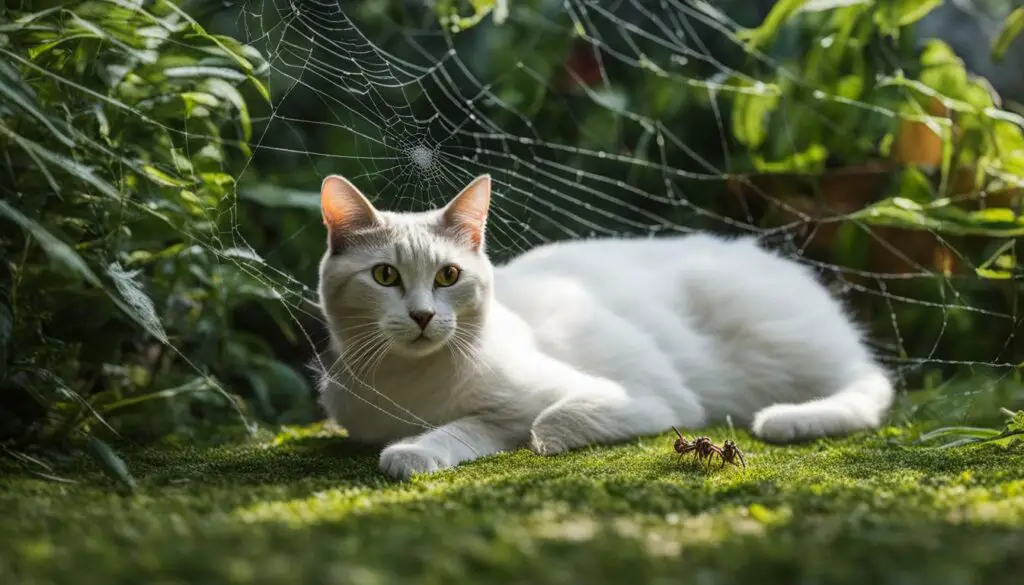
Cat hunting behavior is honed over centuries of evolution, making cats efficient spider hunters. Their agility, keen senses, and ability to stealthily track prey allow them to locate and eliminate spiders with ease. By keeping the spider population in check, cats can help maintain a balance in insect populations and prevent potential infestations in our homes.
Additionally, having cats as feline companions brings added advantages when it comes to spider control. Cats provide a constant presence, patrolling areas where spiders might seek refuge. Their mere presence can act as a deterrent, discouraging spiders from settling in and building webs.
The Role of Cats in Natural Pest Control
By leveraging their hunting instincts, cats contribute to natural pest control efforts, ensuring a healthier and more balanced ecosystem. Their ability to manage spider populations not only helps to reduce the nuisance of these arachnids but also minimizes the risk of spider-related incidents, such as bites, for both humans and cats. With their help, we can enjoy a pest-free environment while fostering a mutually beneficial relationship with our feline companions.
Cats as Companion Animals
Having a cat as a companion can bring numerous benefits to a person’s life. Their endearing and independent nature makes them delightful pets and cherished family members. Cats are known for their unique behaviors and quirks, which add a touch of joy and entertainment to our daily lives.
One of the key benefits of owning a cat is the companionship they provide. Cats can be incredibly affectionate and form strong bonds with their human counterparts. They offer emotional support and can help alleviate stress and anxiety. The soothing presence of a cat can create a sense of calm and tranquility, promoting better mental well-being.
Furthermore, the presence of a cat can encourage physical activity and playfulness. Interacting with a cat through play not only provides exercise for both the cat and the owner but also strengthens the bond between them. The shared moments of joy and laughter can brighten anyone’s day.
It is important to note that owning a cat requires responsibility and commitment. Cats depend on their owners for food, shelter, and veterinary care. Providing a safe and stimulating environment, along with regular feeding and grooming, is essential for a cat’s happiness and well-being. By being responsible cat owners, we can ensure a harmonious and fulfilling cat-human interaction.
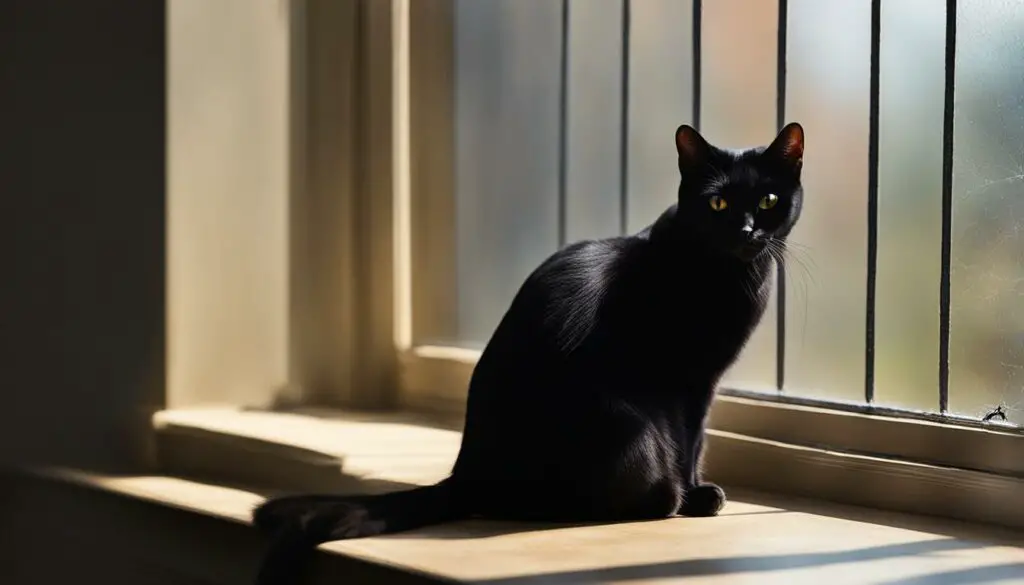
Cat Ownership Benefits
Here are some of the key benefits of owning a cat:
- Companionship: Cats offer unconditional love and companionship, providing comfort and support.
- Stress relief: Interacting with cats can help reduce stress and anxiety, promoting better mental health.
- Physical activity: Playing with a cat encourages physical activity for both the cat and the owner.
- Entertainment: Cats’ playful nature and unique behaviors bring joy and entertainment to our lives.
- Reduced loneliness: Having a cat as a companion can alleviate feelings of loneliness and isolation.
“A cat’s companionship provides unconditional love and emotional support.”
Creating a Positive Cat-Human Interaction
To foster a positive cat-human interaction, it is important to understand cat behavior and meet their needs. Here are some tips:
- Provide a safe and stimulating environment with toys, scratching posts, and cozy resting spots.
- Establish a routine for feeding, playtime, and grooming to maintain a sense of stability.
- Respect your cat’s boundaries and allow them to approach you for affection.
- Interact with your cat through gentle play and positive reinforcement training.
- Regularly schedule visits to the veterinarian for preventive care and vaccinations.
By following these guidelines and understanding the unique needs of cats, we can build a strong and fulfilling relationship with our feline companions.
Cat Safety and Spider-Related Hazards
When it comes to the interaction between cats and spiders, ensuring the safety of our feline companions is crucial. While cats may engage in hunting spiders, it’s important to be aware of potential hazards and take necessary precautions to protect their well-being.
One of the primary concerns is spider bites. Some spiders can be toxic or venomous, posing a threat to our cats’ health. It’s essential to monitor our cats for any signs of spider bites, such as swelling, redness, or abnormal behavior, and seek veterinary care if necessary. Regular visits to the veterinarian, including vaccinations and preventive measures, can help protect our cats from spider-related health concerns.
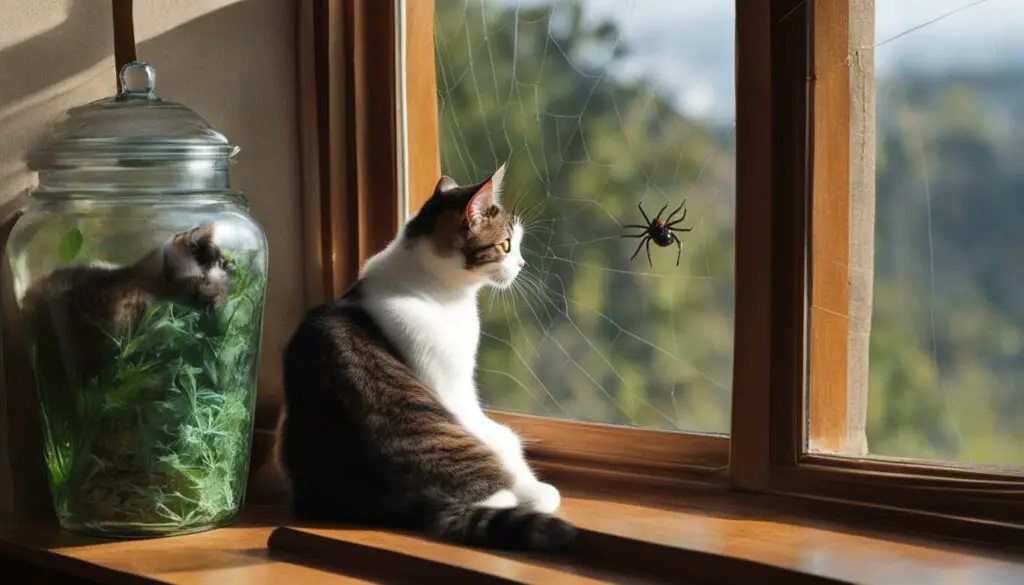
To minimize the risk of spider-human-cat interactions and associated hazards, creating a safe and cat-friendly environment is crucial. This includes regularly inspecting and clearing areas where spiders may be present, such as basements, attics, and outdoor spaces. Additionally, keeping cats indoors can reduce their exposure to spiders and other potential dangers.
| Key Points | Actions |
|---|---|
| Regular veterinary care | Ensure vaccinations and preventive measures |
| Monitoring for spider bites | Look out for signs of swelling, redness, or abnormal behavior |
| Creating a safe environment | Inspect and clear areas where spiders may be present |
| Keeping cats indoors | Reduce exposure to spiders and potential dangers |
Safeguarding our cats from spider-related hazards not only protects their health but also promotes a harmonious spider-human-cat interaction. By taking these precautions and maintaining a cat-friendly environment, we can ensure the well-being and safety of our beloved feline companions.
Spiders and Arachnophobia
Spiders are a common source of fear and phobia among humans. Arachnophobia, the fear of spiders, can be a debilitating condition that affects individuals of all ages. This fear often stems from a combination of factors, including the appearance of spiders, their quick movements, and the potential for venomous bites. But what about cats? How do they interact with spiders and what role do they play in alleviating arachnophobia?
When it comes to cat and spider interaction, there is a wide range of responses. Some cats may exhibit curiosity and interest in spiders, while others may show fear or avoidance. Cats, like humans, have different personalities and preferences, which can affect their reaction to spiders. However, cat owners may find comfort in knowing that cats are natural hunters and have the ability to catch and kill spiders, potentially providing a sense of security in spider-infested areas.
Cat and spider interaction can vary within individual cats as well. While some cats may actively hunt and kill spiders, others may steer clear of them. This variation in behavior may be influenced by factors such as previous experiences, learned behavior, and overall temperament. Understanding and observing the dynamics of cat and spider interaction can not only provide insights into their natural instincts but also help individuals with arachnophobia better comprehend these fascinating creatures.
| Cat Behavior | Spider-Human Interaction |
|---|---|
| Cats may show curiosity, fear, or avoidance towards spiders | Arachnophobia is a common fear among humans |
| Some cats actively hunt and kill spiders | Spiders’ appearance and quick movements can trigger fear in humans |
| Cats’ hunting instincts and ability to catch spiders may provide a sense of security | Venomous spider bites can be a concern for humans |
The Role of Cats in Wildlife Conservation
In the context of wildlife conservation, responsible cat ownership plays a crucial role in mitigating the ecological impact of these invasive predators. Cats, both as domestic pets and feral animals, can have unintended consequences for local wildlife populations. It is essential to understand the importance of cat population control and implement measures to ensure a harmonious coexistence between cats and wildlife.
Responsible cat ownership includes spaying and neutering, which helps to control the cat population and reduce their impact on ecosystems. This practice not only prevents unwanted litters but also minimizes the number of feral cats that can contribute to the decline of native wildlife. By controlling the cat population, we can reduce their predation on birds, small mammals, and other vulnerable species.
Another aspect of responsible cat ownership is keeping our feline companions indoors. Indoor cats not only live longer and healthier lives due to the reduced risk of accidents and exposure to diseases but also pose less threat to wildlife. By keeping our cats indoors, we can protect the local ecosystem from the hunting instincts of these natural predators.
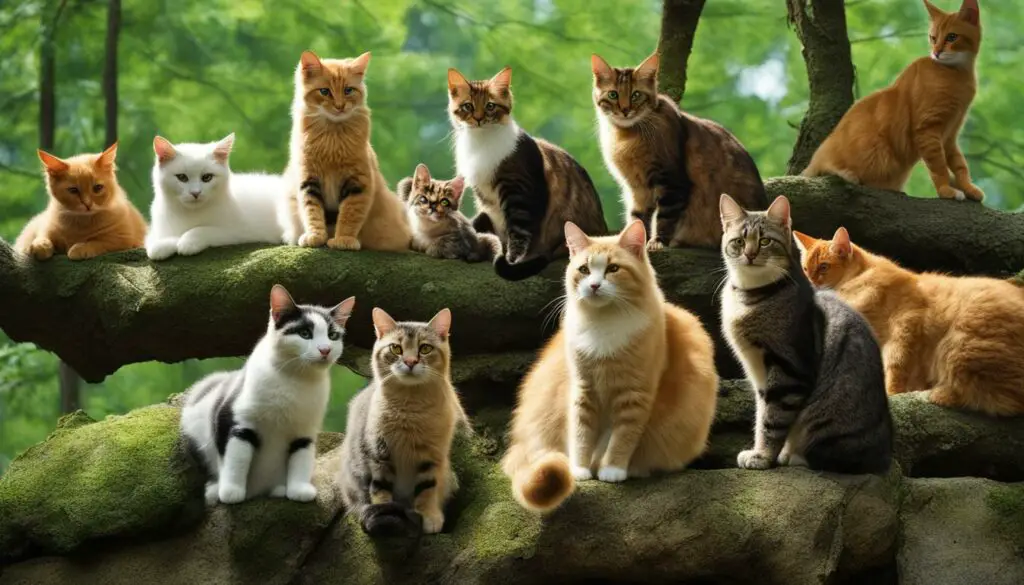
In addition to population control and keeping cats indoors, responsible cat ownership involves providing cats with enrichment activities, such as interactive toys and climbing structures. These activities help keep cats mentally stimulated and satisfied, reducing their desire to hunt and roam in natural habitats.
By adopting responsible cat ownership practices, we can balance the benefits of cat companionship with the need to minimize their impact on wildlife. It is essential to understand that cats are both beloved pets and predators, and by taking responsible actions, we can contribute to the preservation of our natural ecosystems.
Conclusion
In conclusion, the interaction between cats and spiders is a fascinating topic that involves the natural instincts and behaviors of both species. Cats, as natural predators, play a crucial role in pest control by hunting and killing spiders. Their hunting behavior helps manage the population of arachnids and other insects, making them effective bug hunters.
Understanding the anatomy and behavior of spiders is key to comprehending their interaction with cats. Spiders use their silk to create intricate webs for prey capture, while cats rely on their agility and keen senses to locate and ambush their prey. This dynamic interaction between feline predators and arachnid prey contributes to the natural balance of ecosystems.
While cats can be beneficial for pest control, their presence can also have unintended consequences for wildlife conservation. Cats are invasive predators and can disrupt the natural balance of local wildlife populations in sensitive habitats. Responsible cat ownership and measures to minimize cat predation on wildlife are crucial for protecting the ecological integrity of our surroundings.
In conclusion, fostering a harmonious coexistence between cats, humans, and spiders requires understanding and considering the broader implications of their interaction. By being aware of cat behavior, spider ecology, and promoting responsible cat ownership, we can strike a balance between enjoying the benefits of pest control and protecting our ecosystems.
FAQ
Do cats kill spiders?
Yes, cats are natural predators and have a hunting instinct that drives them to hunt and kill spiders.
What is the hunting instinct of cats?
Cats have a strong hunting instinct from a young age, which includes behaviors such as stalking and pouncing.
What is the anatomy of spiders?
Spiders are arachnids with eight legs, fangs for injecting venom, and multiple pairs of eyes. They use silk to create webs for prey capture and locomotion.
How do cats contribute to pest control?
Cats’ hunting behavior helps manage the population of spiders and other insects by keeping their numbers in check.
How do cats interact with spiders?
The interaction between cats and spiders can vary, with some cats actively hunting and killing spiders, while others may exhibit fear or avoidance.
What is the ecological impact of cats killing spiders?
While cats can help control spider populations, their presence can also have unintended consequences for ecosystems, disrupting the natural balance of local wildlife.
How can cat-spider interactions be prevented?
Keeping cats indoors can reduce their exposure to spiders. Providing environmental enrichment and addressing any fears or phobias related to spiders can also help minimize encounters.
How can spider infestations be managed?
Identifying and eliminating potential entry points for spiders, using bug repellents and deterrents, and maintaining a clean environment can help manage spider infestations.
What are the benefits of cats for spider population control?
Cats’ natural hunting instincts contribute to natural pest control and reduce the need for chemical pesticides.
Are there any myths about cats and spiders?
Yes, there are various myths and misconceptions regarding cats and their interaction with spiders.
How can cat safety be ensured regarding spider-related hazards?
Regular veterinary care and maintaining a safe environment can help protect cats from spider bites and other spider-related health concerns.
Do cats contribute to arachnophobia?
Both cats and humans can exhibit fear or aversion towards spiders, although for different reasons. Understanding the dynamics of spider-cat and spider-human interactions can help address concerns related to arachnophobia.
What is the role of cats in wildlife conservation?
While cats can contribute to pest management, they can also have negative impacts on local wildlife populations. Responsible cat ownership is crucial for wildlife conservation efforts.

